Abstract
The role of adenosine receptors in the regulation of muscle glucose uptake by insulin and contractions was studied in isolated rat hindquarters that were perfused with a standard medium containing no insulin or a submaximal concentration of 100 microU/ml. Adenosine receptor antagonism was induced by caffeine or 8-cyclopentyl-1,3-dipropylxantine (CPDPX). Glucose uptake and transport were measured before and during 30 min of electrically induced muscle contractions. Caffeine nor CPDPX affected glucose uptake in resting hindquarters. In contrast, the contraction-induced increase in muscle glucose uptake was inhibited by 30-50% by caffeine, as well as by CPDPX, resulting in a 20-25% decrease in the absolute rate of glucose uptake during contractions, compared with control values. This inhibition was independent of the rate of perfusate flow and only occurred in hindquarters perfused with insulin added to the medium. Thus, adenosine receptor antagonism inhibited glucose uptake during simultaneous exposure to insulin and contractions only. Accordingly, caffeine inhibited 3-O-methylglucose uptake during contractions only in oxidative muscle fibers that are characterized by a high sensitivity to insulin. In conclusion, the present data demonstrate A1 receptors to regulate insulin-mediated glucose transport in contracting skeletal muscle. The findings provide evidence that stimulation of sarcolemmic adenosine receptors during contractions is involved in the synergistic stimulation of muscle glucose transport by insulin and by contractions.
Full text
PDF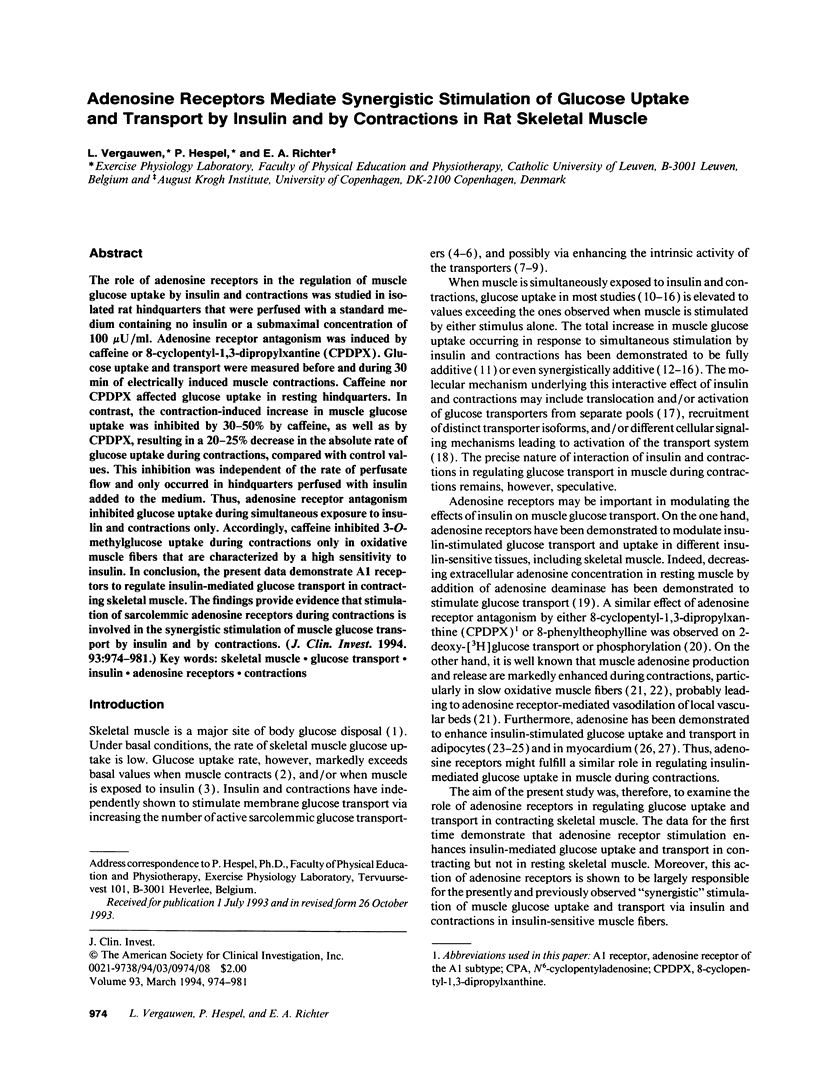
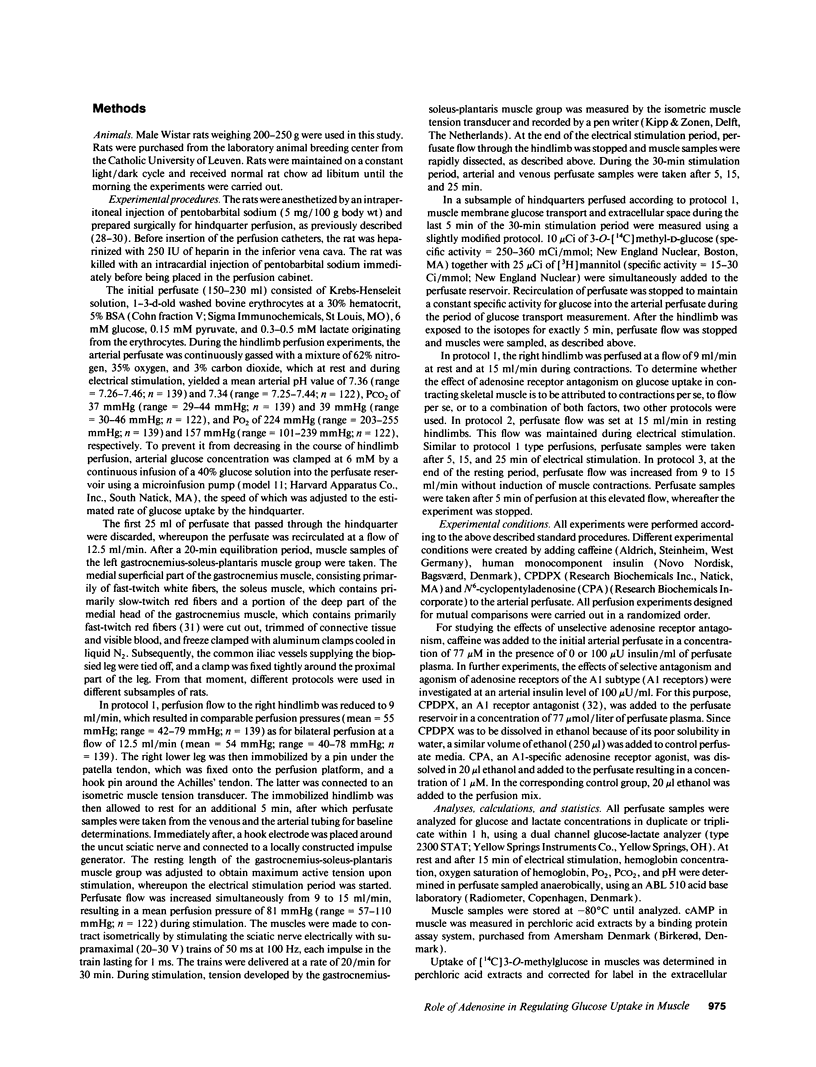

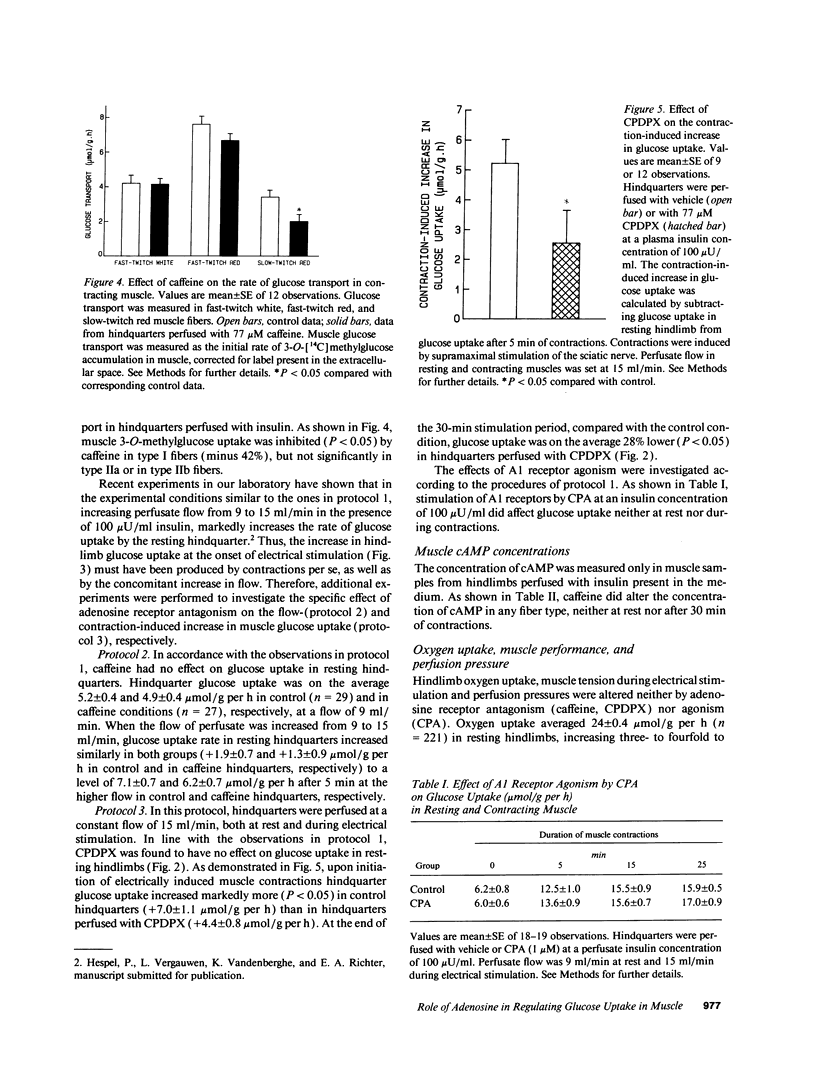


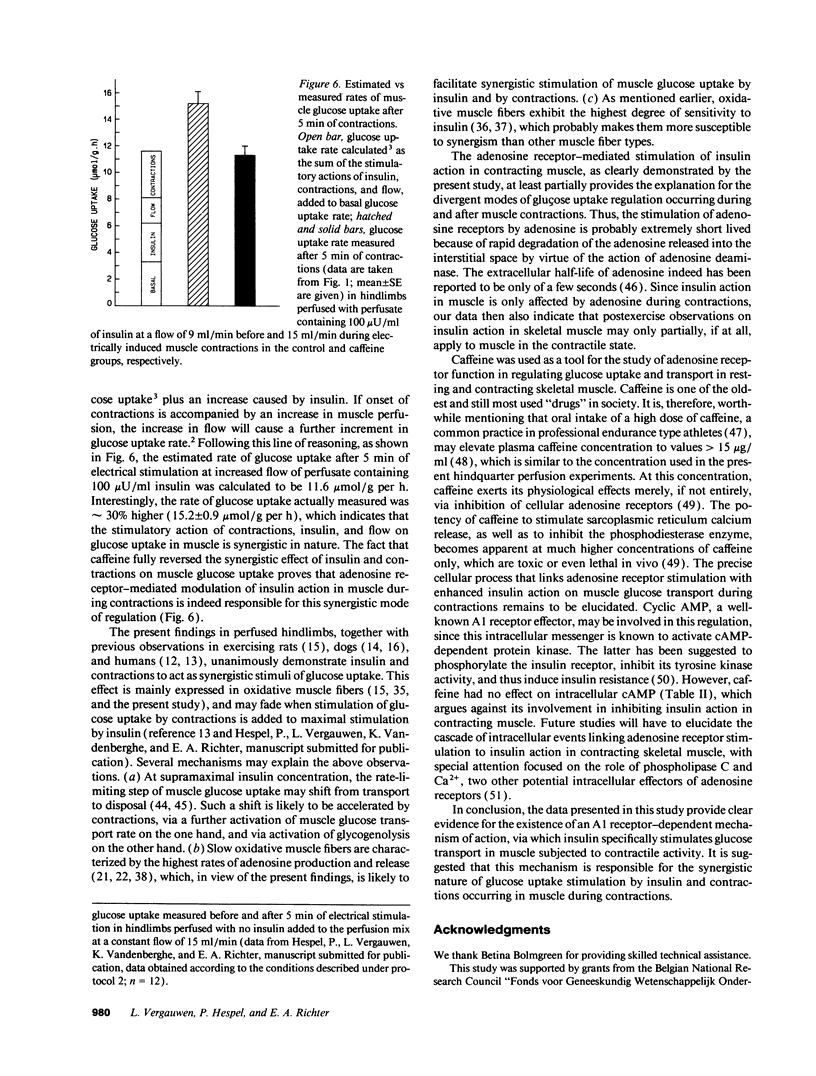
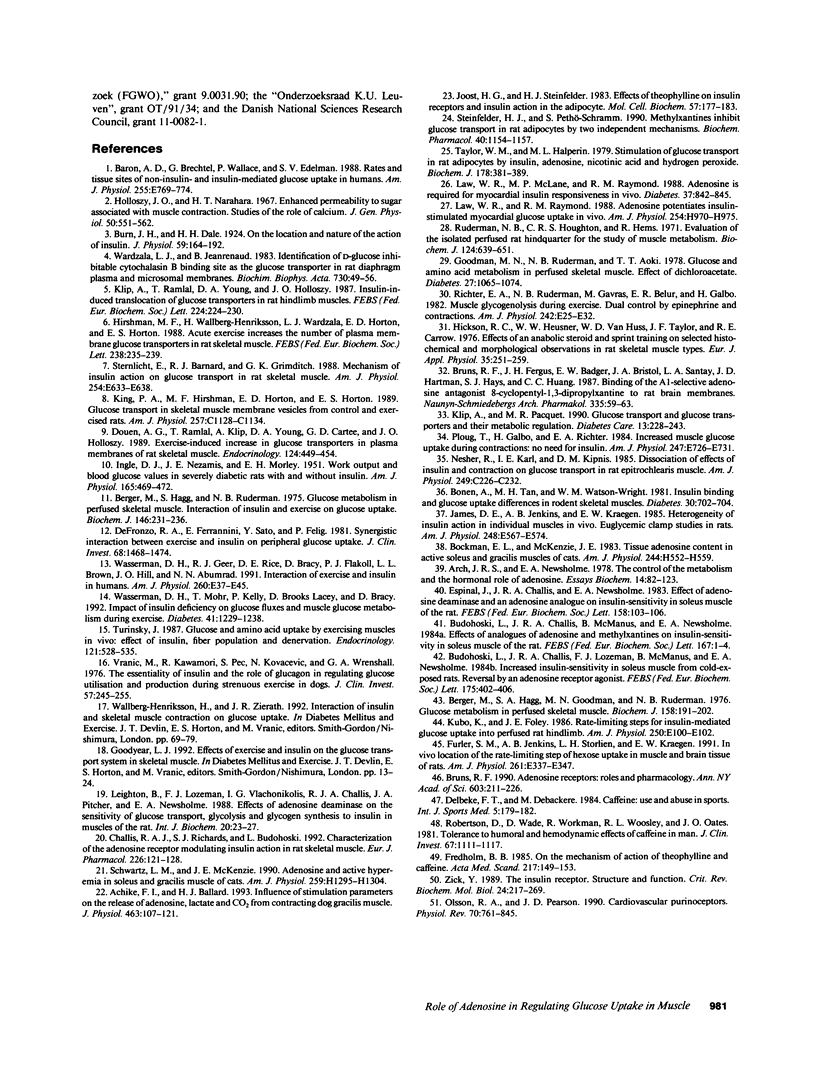
Selected References
These references are in PubMed. This may not be the complete list of references from this article.
- Achike F. I., Ballard H. J. Influence of stimulation parameters on the release of adenosine, lactate and CO2 from contracting dog gracilis muscle. J Physiol. 1993 Apr;463:107–121. doi: 10.1113/jphysiol.1993.sp019586. [DOI] [PMC free article] [PubMed] [Google Scholar]
- Arch J. R., Newsholme E. A. The control of the metabolism and the hormonal role of adenosine. Essays Biochem. 1978;14:82–123. [PubMed] [Google Scholar]
- Baron A. D., Brechtel G., Wallace P., Edelman S. V. Rates and tissue sites of non-insulin- and insulin-mediated glucose uptake in humans. Am J Physiol. 1988 Dec;255(6 Pt 1):E769–E774. doi: 10.1152/ajpendo.1988.255.6.E769. [DOI] [PubMed] [Google Scholar]
- Berger M., Hagg S. A., Goodman M. N., Ruderman N. B. Glucose metabolism in perfused skeletal muscle. Effects of starvation, diabetes, fatty acids, acetoacetate, insulin and exercise on glucose uptake and disposition. Biochem J. 1976 Aug 15;158(2):191–202. doi: 10.1042/bj1580191. [DOI] [PMC free article] [PubMed] [Google Scholar]
- Berger M., Hagg S., Ruderman N. B. Glucose metabolism in perfused skeletal muscle. Interaction of insulin and exercise on glucose uptake. Biochem J. 1975 Jan;146(1):231–238. doi: 10.1042/bj1460231. [DOI] [PMC free article] [PubMed] [Google Scholar]
- Bockman E. L., McKenzie J. E. Tissue adenosine content in active soleus and gracilis muscles of cats. Am J Physiol. 1983 Apr;244(4):H552–H559. doi: 10.1152/ajpheart.1983.244.4.H552. [DOI] [PubMed] [Google Scholar]
- Bonen A., Tan M. H., Watson-Wright W. M. Insulin binding and glucose uptake differences in rodent skeletal muscles. Diabetes. 1981 Aug;30(8):702–704. doi: 10.2337/diab.30.8.702. [DOI] [PubMed] [Google Scholar]
- Bruns R. F. Adenosine receptors. Roles and pharmacology. Ann N Y Acad Sci. 1990;603:211–226. doi: 10.1111/j.1749-6632.1990.tb37674.x. [DOI] [PubMed] [Google Scholar]
- Bruns R. F., Fergus J. H., Badger E. W., Bristol J. A., Santay L. A., Hartman J. D., Hays S. J., Huang C. C. Binding of the A1-selective adenosine antagonist 8-cyclopentyl-1,3-dipropylxanthine to rat brain membranes. Naunyn Schmiedebergs Arch Pharmacol. 1987 Jan;335(1):59–63. doi: 10.1007/BF00165037. [DOI] [PubMed] [Google Scholar]
- Budohoski L., Challiss R. A., Lozeman F. J., McManus B., Newsholme E. A. Increased insulin sensitivity in soleus muscle from cold-exposed rats: reversal by an adenosine-receptor agonist. FEBS Lett. 1984 Oct 1;175(2):402–406. doi: 10.1016/0014-5793(84)80777-2. [DOI] [PubMed] [Google Scholar]
- Burn J. H., Dale H. H. On the location and nature of the action of insulin. J Physiol. 1924 Oct 9;59(2-3):164–192. doi: 10.1113/jphysiol.1924.sp002173. [DOI] [PMC free article] [PubMed] [Google Scholar]
- Challiss R. A., Richards S. J., Budohoski L. Characterization of the adenosine receptor modulating insulin action in rat skeletal muscle. Eur J Pharmacol. 1992 Jun 5;226(2):121–128. doi: 10.1016/0922-4106(92)90172-r. [DOI] [PubMed] [Google Scholar]
- DeFronzo R. A., Ferrannini E., Sato Y., Felig P., Wahren J. Synergistic interaction between exercise and insulin on peripheral glucose uptake. J Clin Invest. 1981 Dec;68(6):1468–1474. doi: 10.1172/JCI110399. [DOI] [PMC free article] [PubMed] [Google Scholar]
- Delbeke F. T., Debackere M. Caffeine: use and abuse in sports. Int J Sports Med. 1984 Aug;5(4):179–182. doi: 10.1055/s-2008-1025901. [DOI] [PubMed] [Google Scholar]
- Douen A. G., Ramlal T., Klip A., Young D. A., Cartee G. D., Holloszy J. O. Exercise-induced increase in glucose transporters in plasma membranes of rat skeletal muscle. Endocrinology. 1989 Jan;124(1):449–454. doi: 10.1210/endo-124-1-449. [DOI] [PubMed] [Google Scholar]
- Espinal J., Challiss R. A., Newsholme E. A. Effect of adenosine deaminase and an adenosine analogue on insulin sensitivity in soleus muscle of the rat. FEBS Lett. 1983 Jul 11;158(1):103–106. doi: 10.1016/0014-5793(83)80685-1. [DOI] [PubMed] [Google Scholar]
- Fredholm B. B. On the mechanism of action of theophylline and caffeine. Acta Med Scand. 1985;217(2):149–153. doi: 10.1111/j.0954-6820.1985.tb01650.x. [DOI] [PubMed] [Google Scholar]
- Furler S. M., Jenkins A. B., Storlien L. H., Kraegen E. W. In vivo location of the rate-limiting step of hexose uptake in muscle and brain tissue of rats. Am J Physiol. 1991 Sep;261(3 Pt 1):E337–E347. doi: 10.1152/ajpendo.1991.261.3.E337. [DOI] [PubMed] [Google Scholar]
- Goodman M. N., Ruderman N. B., Aoki T. T. Glucose and amino acid metabolism in perfused skeletal muscle. Effect of dichloroacetate. Diabetes. 1978 Nov;27(11):1065–1074. doi: 10.2337/diab.27.11.1065. [DOI] [PubMed] [Google Scholar]
- Hickson R. C., Heusner W. W., Van Huss W. D., Taylor J. F., Carrow R. E. Effects of an anabolic steroid and sprint training on selected histochemical and morphological observations in rat skeletal muscle types. Eur J Appl Physiol Occup Physiol. 1976 Sep 23;35(4):251–259. doi: 10.1007/BF00423284. [DOI] [PubMed] [Google Scholar]
- Hirshman M. F., Wallberg-Henriksson H., Wardzala L. J., Horton E. D., Horton E. S. Acute exercise increases the number of plasma membrane glucose transporters in rat skeletal muscle. FEBS Lett. 1988 Oct 10;238(2):235–239. doi: 10.1016/0014-5793(88)80486-1. [DOI] [PubMed] [Google Scholar]
- Holloszy J. O., Narahara H. T. Enhanced permeability to sugar associated with muscle contraction. Studies of the role of Ca++. J Gen Physiol. 1967 Jan;50(3):551–562. doi: 10.1085/jgp.50.3.551. [DOI] [PMC free article] [PubMed] [Google Scholar]
- INGLE D. J., NEZAMIS J. E., MORLEY E. H. Work output and blood glucose values in severely diabetic rats with and without insulin. Am J Physiol. 1951 May;165(2):469–472. doi: 10.1152/ajplegacy.1951.165.2.469. [DOI] [PubMed] [Google Scholar]
- James D. E., Jenkins A. B., Kraegen E. W. Heterogeneity of insulin action in individual muscles in vivo: euglycemic clamp studies in rats. Am J Physiol. 1985 May;248(5 Pt 1):E567–E574. doi: 10.1152/ajpendo.1985.248.5.E567. [DOI] [PubMed] [Google Scholar]
- Joost H. G., Steinfelder H. J. Effects of theophylline on insulin receptors and insulin action in the adipocyte. Mol Cell Biochem. 1983;57(2):177–183. doi: 10.1007/BF00849194. [DOI] [PubMed] [Google Scholar]
- Klip A., Pâquet M. R. Glucose transport and glucose transporters in muscle and their metabolic regulation. Diabetes Care. 1990 Mar;13(3):228–243. doi: 10.2337/diacare.13.3.228. [DOI] [PubMed] [Google Scholar]
- Klip A., Ramlal T., Young D. A., Holloszy J. O. Insulin-induced translocation of glucose transporters in rat hindlimb muscles. FEBS Lett. 1987 Nov 16;224(1):224–230. doi: 10.1016/0014-5793(87)80452-0. [DOI] [PubMed] [Google Scholar]
- Kubo K., Foley J. E. Rate-limiting steps for insulin-mediated glucose uptake into perfused rat hindlimb. Am J Physiol. 1986 Jan;250(1 Pt 1):E100–E102. doi: 10.1152/ajpendo.1986.250.1.E100. [DOI] [PubMed] [Google Scholar]
- Law W. R., McLane M. P., Raymond R. M. Adenosine is required for myocardial insulin responsiveness in vivo. Diabetes. 1988 Jun;37(6):842–845. doi: 10.2337/diab.37.6.842. [DOI] [PubMed] [Google Scholar]
- Law W. R., Raymond R. M. Adenosine potentiates insulin-stimulated myocardial glucose uptake in vivo. Am J Physiol. 1988 May;254(5 Pt 2):H970–H975. doi: 10.1152/ajpheart.1988.254.5.H970. [DOI] [PubMed] [Google Scholar]
- Leighton B., Lozeman F. J., Vlachonikolis I. G., Challiss R. A., Pitcher J. A., Newsholme E. A. Effects of adenosine deaminase on the sensitivity of glucose transport, glycolysis and glycogen synthesis to insulin in muscles of the rat. Int J Biochem. 1988;20(1):23–27. doi: 10.1016/0020-711x(88)90005-5. [DOI] [PubMed] [Google Scholar]
- Nesher R., Karl I. E., Kipnis D. M. Dissociation of effects of insulin and contraction on glucose transport in rat epitrochlearis muscle. Am J Physiol. 1985 Sep;249(3 Pt 1):C226–C232. doi: 10.1152/ajpcell.1985.249.3.C226. [DOI] [PubMed] [Google Scholar]
- Olsson R. A., Pearson J. D. Cardiovascular purinoceptors. Physiol Rev. 1990 Jul;70(3):761–845. doi: 10.1152/physrev.1990.70.3.761. [DOI] [PubMed] [Google Scholar]
- Ploug T., Galbo H., Richter E. A. Increased muscle glucose uptake during contractions: no need for insulin. Am J Physiol. 1984 Dec;247(6 Pt 1):E726–E731. doi: 10.1152/ajpendo.1984.247.6.E726. [DOI] [PubMed] [Google Scholar]
- Richter E. A., Ruderman N. B., Gavras H., Belur E. R., Galbo H. Muscle glycogenolysis during exercise: dual control by epinephrine and contractions. Am J Physiol. 1982 Jan;242(1):E25–E32. doi: 10.1152/ajpendo.1982.242.1.E25. [DOI] [PubMed] [Google Scholar]
- Robertson D., Wade D., Workman R., Woosley R. L., Oates J. A. Tolerance to the humoral and hemodynamic effects of caffeine in man. J Clin Invest. 1981 Apr;67(4):1111–1117. doi: 10.1172/JCI110124. [DOI] [PMC free article] [PubMed] [Google Scholar]
- Ruderman N. B., Houghton C. R., Hems R. Evaluation of the isolated perfused rat hindquarter for the study of muscle metabolism. Biochem J. 1971 Sep;124(3):639–651. doi: 10.1042/bj1240639. [DOI] [PMC free article] [PubMed] [Google Scholar]
- Steinfelder H. J., Pethö-Schramm S. Methylxanthines inhibit glucose transport in rat adipocytes by two independent mechanisms. Biochem Pharmacol. 1990 Sep 1;40(5):1154–1157. doi: 10.1016/0006-2952(90)90508-i. [DOI] [PubMed] [Google Scholar]
- Sternlicht E., Barnard R. J., Grimditch G. K. Mechanism of insulin action on glucose transport in rat skeletal muscle. Am J Physiol. 1988 May;254(5 Pt 1):E633–E638. doi: 10.1152/ajpendo.1988.254.5.E633. [DOI] [PubMed] [Google Scholar]
- Taylor W. M., Halperin M. L. Stimulation of glucose transport in rat adipocytes by insulin, adenosine, nicotinic acid and hydrogen peroxide. Role of adenosine 3':5'-cyclic monophosphate. Biochem J. 1979 Feb 15;178(2):381–389. doi: 10.1042/bj1780381. [DOI] [PMC free article] [PubMed] [Google Scholar]
- Turinsky J. Glucose and amino acid uptake by exercising muscles in vivo: effect of insulin, fiber population, and denervation. Endocrinology. 1987 Aug;121(2):528–535. doi: 10.1210/endo-121-2-528. [DOI] [PubMed] [Google Scholar]
- Vranic M., Kawamori R., Pek S., Kovacevic N., Wrenshall G. A. The essentiality of insulin and the role of glucagon in regulating glucose utilization and production during strenuous exercise in dogs. J Clin Invest. 1976 Feb;57(2):245–255. doi: 10.1172/JCI108275. [DOI] [PMC free article] [PubMed] [Google Scholar]
- Wardzala L. J., Jeanrenaud B. Identification of the D-glucose-inhibitable cytochalasin B binding site as the glucose transporter in rat diaphragm plasma and microsomal membranes. Biochim Biophys Acta. 1983 Apr 21;730(1):49–56. doi: 10.1016/0005-2736(83)90315-2. [DOI] [PubMed] [Google Scholar]
- Wasserman D. H., Geer R. J., Rice D. E., Bracy D., Flakoll P. J., Brown L. L., Hill J. O., Abumrad N. N. Interaction of exercise and insulin action in humans. Am J Physiol. 1991 Jan;260(1 Pt 1):E37–E45. doi: 10.1152/ajpendo.1991.260.1.E37. [DOI] [PubMed] [Google Scholar]
- Wasserman D. H., Mohr T., Kelly P., Lacy D. B., Bracy D. Impact of insulin deficiency on glucose fluxes and muscle glucose metabolism during exercise. Diabetes. 1992 Oct;41(10):1229–1238. doi: 10.2337/diab.41.10.1229. [DOI] [PubMed] [Google Scholar]
- Zick Y. The insulin receptor: structure and function. Crit Rev Biochem Mol Biol. 1989;24(3):217–269. doi: 10.3109/10409238909082554. [DOI] [PubMed] [Google Scholar]


